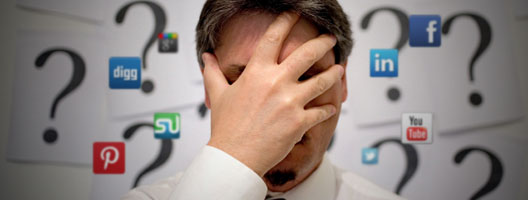troll you just for the fun of it.
Should any of these online perils stop you from using social media for your event? Absolutely, positively NOT!
Missteps are a part of the event planning experience and, as I like to tell organizers, if you’re not making, at least, a few mistakes you’re not trying hard enough.
To help you avoid some of the most common social media snafus, I’ve put together a nice and neat list of 7 social media missteps I see organizers make and, most importantly, how to avoid them entirely. Lets get started…
1. Going Hashtag Crazy
Hashtags are a great tool to use for your event. They provide an easy way to find relevant tweets and give you and your attendees an effective way to communicate on a massively popular social media platform. That being said, going overboard with your hashtag usage can be just as detrimental as using it properly can be beneficial.
As a general rule of thumb, avoid using more than 2 hashtags per tweet to avoid confusing attendees and diluting the effectiveness of the hashtags you do use. I also recommend choosing one hashtag that is specific to your event (ie – #BensComicCon14) and another that is much broader and more widely used. This way you have one hashtag your attendees can use to discuss your event and another that can spark better engagement from a big pool of Twitter users.
2. Not Having Someone Primarily Focused on Social Media
Many organizers think they can organize an entire event AND manage the social media before, during and after. Think again!
Handling an event’s social media is a big undertaking that requires constant attention and quick responses to attendees, sponsors and more. A good social media coordinator not only placates upset attendees and avoid rookie social media blunders, but also actively participates in conversations online and even helps drive ticket sales.
Whether you hire a professional or just use someone from your existing team, dedicating someone to manage your event’s social media is one steps you can take to avoid unnecessary social media blunders.
3. Ignoring The Bad
Inevitably, your event is going to receive some negative comments on social media. While receiving unfavorable comments isn’t great, what’s worse is refusing to even acknowledge them.
Ignoring one bad piece of feedback on social media only causes the ill sentiments to grow and spread until, before you realize it, you have a chorus of angry attendees demanding a response (and by that point nothing you say will not be a good enough answer).
Before your event even starts, go over how you will respond to negative feedback, both online and at the event, and then, when the time comes, respond swiftly.
4. Soliciting Attendees To Promote Your Event
Let me first say that politely or innocuously asking attendees to share info about your event is not ALWAYS a negative thing. If fact, when you provide value in doing so (a discount, free gift, etc), asking attendees to promote is a powerful marketing tool.
Soliciting or begging for promotion, on the other, is an absolute no-no. It provides no value to the attendee and cheapens your brand. I advise organizers to rarely ask for promotion from their attendees. Instead, focus on making your event so awesome your attendees won’t need any provocation to promote and spread the buzz.
5. Not Using The Channels Your Attendees Use
While Facebook and Twitter are considered the “must use” social media channels for events, if your attendees or target attendees are on a different kind of social media, you should be too. The burden of information is not on your guests to receive the information about your event, but on YOU to provide it in the most convenient way.
Ask attendees from a previous event what social media they use or do some research on common channels for a certain type of event. The easier and more comfortable you can make the communication process on social media, the more confidence your guests will have in purchasing a ticket.
6. The “One-and-done” Post
A “one-and-done” post, as the name suggests, is content that is shared once and then never referenced or re-posted again. Most often, I see organizers do this because they’re worried posting too much about the same thing will annoy their attendees. Let me assuage your fears right now: not only is it okay to post multiple times about one thing, I highly recommend it!
The shelf life of a post is relatively short and social media users check their accounts sporadically. This means the third time you post about your event’s new speaker might actually be the first time an attendee actually sees and reads it. I frequently use the acronym ICYMI (In Case You Missed It) before repeat posts to alert the user that this post has been posted before and that I believe it’s something they really need to check out.
7. Not Making Your Tweets “Retweetable”
When someone retweets something you shared, their handle appears in the tweet along with the message you originally sent. If you used too many characters (the maximum amount is 140) in your original tweet, the addition of the retweeters handle cause parts to be cut off and your message will be incomplete.
This is one of the most common missteps but, fortunately, also one of the easiest to correct. All you need to do is simply be sure to leave some space in your tweets for others to retweet. A good rule of thumb is to leave 8-12 characters of space. Do this and retweeters should have no problem sharing your full message.
]]]]> ]]>
